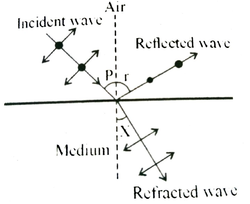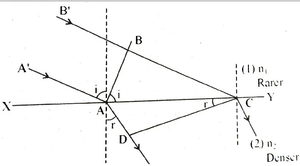| An upolarised hight incident on a medium as shown in figure Show that the direction of reflected and refracted waves are mutually perpendicular |
 |
| Previous Year Questions of March Examinations from 2010 to 2020 |
| Chapter Name: WAVE OPTICS |
|
Brewster’s law gives a relationship between angle of polarisation and refractive index of the material. a) State Brewster’s law. b) A ray of light is allowed to incident on the surface of a glass plate and it is found that the reflected and refracted rays are mutually perpendicular. The refracted ray is deviated from its initial path by an angle of 300. Determine the refractive index of the glass plate. |
|
In interference and diffraction of light, dark and bright bands are seen on the screen. a) Do these phenomena violate the law of conservation of energy? Explain. b) In an interference pattern, the ratio of maximum intensity is 36: 9. Find the ratio of amplitude and intensities of the two interfering waves. |
Match the following:
|
|
Various phenomena exhibited by light can be explained using the wave theory of light a) Name the phenomenon which proves the transverse nature of light b) What are the differences between interference and diffraction? c) A plane wave front is incident on a single slit. Discuss the diffraction pattern formed by the slit. Represent the variation of intensity graphically |
| a) Describe Young’s experiment in interference with necessary theory b) Explain the refraction at a spherical surface using a schematic diagram c) Mention the shape of wave front for the portion of wave front of light from a distant star intercepted by the earth |
|
We obtained alternate dark and bright region if we look at the shadow by an obstacle
closed to geometrical shadow a) Mention the phenomenon behind it b) Differentiate the interference pattern with a coherently illuminated single slit diffraction pattern |
|
(A) Interference of light from two sources can be observed if (a) the sources are independent (b) the sources are of different frequencies and random phases (c) the sources are of different frequency (d) the sources are coherent (B) Draw Young’s arrangement to produce interference pattern (C) Derive an expression for the fringe width of interference pattern formed on the screen (D) Write the condition to produce good interference bands |
|
(a) Unpolarised light is incident on a plane glass surface. What should be the angle of incidence so that the reflected and refracted rays are perpendicular to each other? (n = 1.5) (b) Using Huygenss concept of wave front, derive Snells law of refraction |
|
(a) Light waves from two coherent sources having intensities I and 2I cross each other at a point with a phase difference of 600 . What is the resultant intensity at the point? (b) With the help of a diagram obtain an expression for finding the distance between two consecutive bright or dark fringes in the interference pattern produced by double slits |
|
(a) Sound waves do not exhibit (i) interference (ii) polarisation (iii) diffraction (iv) reflection (b) Describe Young"s double slit experiment to determine bandwidth of the interference pattem |
|
(a) The intensity of scattered light in Rayleigh scattering is proportional to ...................... (b) Explain the diffraction pattern obtained due to a single slit and represent graphically the variation of intensity with angle of diffraction |
| An upolarised hight incident on a medium as shown in figure Show that the direction of reflected and refracted waves are mutually perpendicular |
 |
| A plane wave-front AB incident on a surface XY and undergoes refraction as shown in figure (a) Prove Snell"s law of refraction by using this figure (b) What is the change in speed of propagation and frequency of the refracted wave? |
 |
| Write any two uses of Polaroids. |
| Describe Young"s double slit experiment and derive an expression for the bandwidth of the interference band. |
|
A long narrow slit is illuminated by blue light and the diffraction pattern is obtained on a white screen. (a) How the width of bands change as the distance from the centre increases ? (b) What happens to the width of pattern, if yellow light is used instead of blue light ? (c) In a double slit experiment, the slits are separated by 0.03 cm and the screen is placed 1.5 m away. The distance between the central fringe and the fourth bright fringe is 1 cm. Determine the wavelength of light used in the experiment. (d) What do you mean by limit of resolution of an optical instrument ? |